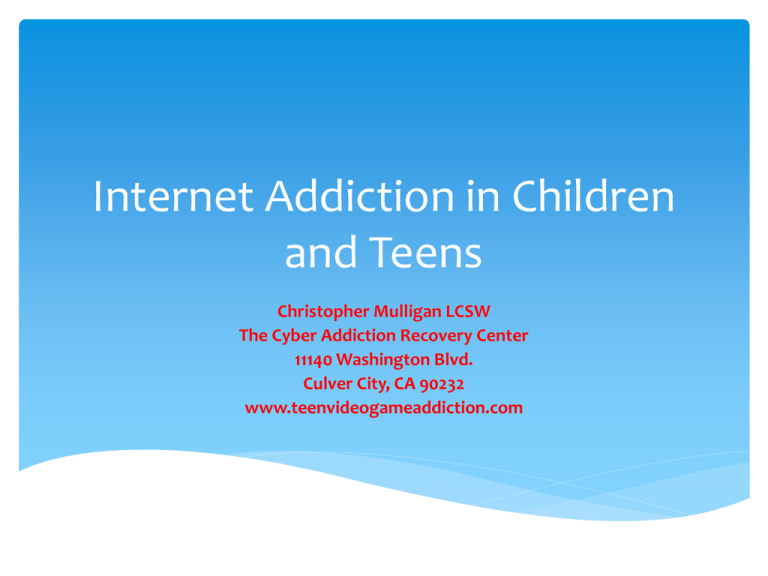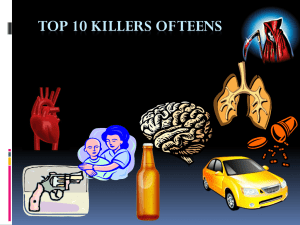
Internet Addiction in Children
and Teens
Christopher Mulligan LCSW
The Cyber Addiction Recovery Center
11140 Washington Blvd.
Culver City, CA 90232
www.teenvideogameaddiction.com
Framework for Presentation
1) There is a subgroup of children and teens for whom the
Internet and gaming should be viewed as a public health
problem – a public health problem that we as a society are
struggling to recognize and address.
2)The internet and gaming can be viewed in terms of a
massive, unfiltered, source of stimulation that affects
multiple domains of development: social, emotional,
attachment, cognitive, communication, and sensory motor.
3) Any discussion of online safety should include a
discussion of the impact of the internet – and technology
more generally – is having on child and adolescent
development and mental health.
Teen use of the “net”
Over the past five years the Internet has come to
occupy a central place in the lives of children and
teens.
Teens use the Internet for communication with friends
and family, school-related research, artistic expression,
recreation, purchasing music/videos, and participation
in local and global political movements.
Most teens view the Internet as a way of enhancing
their off-line lives and are able to find a balance
between the time they spend in three dimensional
reality and virtual reality.
Kaiser Family Foundation Study: 11
hours per day
The average amount of time teens are now “connected” to
tech is 11 hours per day. What?
Although there is no specific amount of time on the internet
that has been confirmed to result in addiction or mental
health problems in teens , it is clear that teens who lose the
ability to balance their interest in online activities and offline activities, experience significant social, emotional, and
academic problems.
Constant engagement with online activities can reduce
motivation to develop and expand crucial offline socialemotional capacities such as self-awareness, empathy,
resilience, initiative, deliberation, and collaboration.
The 10 percent
Unfortunately, there is a sizable minority of teens -- current
research suggests as many as 10% -- that cannot regulate their use
of the Internet and lose their ability to balance their off-line and
online lives.
There is an ongoing debate within the medical and mental health
communities about whether the term “addiction” should be
applied to teens and adults who have lost the capacity to regulate
their use of the internet and gaming .
Medical and mental health professionals are also debating
whether sustained use of the internet results in and/or
exacerbates depression, anxiety, personality disorders, and
psychotic states.
Challenges with Internet Addiction Research
• There is disagreement among specialists regarding definition of
“addiction”
• Measures have been based on physical addiction models
• Measures have not been extensively validated
• Most studies are based on self report surveys and are only
correlational
• Many studies are too small or selective (e.g., based on students)
• Internet and technology behavior is very complex, and not a single
construct
• There is little consistency in findings regarding approach or
treatment
Teens and Net Addiction?
Although this debate is far from being
resolved -- and therefore additional research
is needed -- it is clear to clinicians that
specialize in problematic technology use that
there is a subset of teens who exhibit
behaviors seen in process or behavioral
addictions such as gambling, shopping, and
sexual activity.
Process Addiction
“Process Addiction” – disorder of
behavior, not abuse of a substance
“Pathological Internet Use” (PIU)
Term coined by Kimberly Young, Ph.D.
Types of Potential Overuse
• Checking e-mail
• Facebook, Twitter, etc
• Texting
• Multitasking
• Switchtasking
• News browsing
• Web surfing
• Online gaming
Types of Potential Overuse
• Online shopping/bidding
• Chatrooms
• Online gambling
• Online pornography
• Cybersex
• Cyber bullying
The Hook: The Dopamine Rush
Internet use, especially social applications such as email, texting, instant messaging, and social media
sites, result in the activation of “pleasure centers” in
the brain which, in turn, results in an increase in the
level of the neurotransmitter dopamine.
Dopamine is a neurotransmitter that is increased by
both substance and process addictions: cocaine,
compulsive shopping, gambling, and sexual activity.
High levels of dopamine produce high levels of pleasure
- including euphoric states - which can result in a
teenager pursuing online activities at the expense of
focusing on off-line activities and responsibilities.
Dopamine and Desensitization and
Tolerance
• Dopamine levels can be affected by heredity and
trauma
• Frequent release of dopamine reduces the number
and sensitivity of dopamine receptors– more
stimulation is required to achieve the same pleasure
(desensitization & tolerance)
• Cravings are stimulated by cues or delay in
involvement in the stimulating activity
Dopamine Pathways
How media becomes addictive:
reinforcement schedule
• Variable (intermittent) ratio reinforcement
schedule.
• Create a state of anticipation/expectation.
• Facebook requests, photo tags, friend updates, direct
messages, and chat all create anticipation.
• Dopamine keeps users craving more; it drives stimulation
seeking.
• Some people have as much as a 9% increase in dopamine when
they listen to their favorite music (cocaine is 22%) (Salimpoor et
al., 2009).
Signs of Internet Addiction
Cravings/preoccupation: teens develop an almost constant
craving/psychological preoccupation with being online via
the computer and/or smart phone.
Tolerance: teens develop the need to spend increasing
amounts of time online in order to feel excitement and
satisfaction (e.g., one hour per day becomes three hours
and three hours becomes five hours).
Withdrawal symptoms: teens experience anxiety,
anger/rage, irritability, and/or depression when they are off
line.
Persistence of behavior despite negative consequences:
teens continue to engage in ever-increasing amounts of
time online despite obvious negative consequences, e.g.,
conflict with parents, loss of off-line friendships, neglect of
school work, failing grades, neglect of chores, reduction in
physical activity, fatigue, and overall poor health.
Signs of Internet Addiction
Social communications and interests are lost: loss
of interest in hobbies, social interaction, and
recreation.
Alleviation of negative emotions: use of the
internet to escape or alleviate dysphoric mood
(e.g., feelings of helplessness, hopelessness, guilt,
anxiety).
Hiding use from friends and relatives: deception
of actual costs/time of internet involvement to
family, friends, therapists, and others.
The Internet’s Impact on Mental
Health
In addition to addiction, researchers and clinicians
world wide are seeing a cluster of serious mental
health problems that appear to be caused by or
exacerbated by the overuse of the internet.
What is known about the impact of the Internet
on adolescent mental health?
The following represents a summary of current
thinking on the impact of the internet on
adolescent mental health.
At risk groups: depression and
compulsive net use
Although the internet increases dopamine, teens who spend
significant amounts of time online (25-30 hours per week)
frequently present with symptoms of depression.
Multiple studies have shown that teens and adults who
devote a significant majority of their social and recreational
time to online activities and relationships, present with
symptoms of depression.
It is not clear at this time whether being online 25 or more
hours per week produces depression or whether teens who
have depression seek out Internet related social and
recreational activities.
In either case, the Internet does not improve the mood of
teenagers and may in fact produce a mood disorder or
exacerbate a pre-existing mood disorder.
At risk groups: the net and ADHD
Teens that have been diagnosed with ADHD are
drawn to the Internet, particularly online gaming.
It has long been documented that teens with ADHD
are at high risk for drug and alcohol addiction due to
deficits in the functioning of the prefrontal cortex.
Research has confirmed that teens with ADHD are
drawn to the dopamine producing activities offered by
the Internet, resulting in high rates of
compulsive/addictive use of technology.
Internet use for the ADHD teen appears increase their
core deficits by providing a way to experience
constant novelty and dopamine induced euphoric
states.
The net and Autism: a worst case
scenario
Teens with Autism are also vulnerable to the compulsive
use of the Internet, including online gaming, social media
sites, YouTube videos, and research on areas of special
interest.
The problem for the teen with Autism is the pleasure that
is experienced through the Internet serves as an obstacle
for remediating the core social and cognitive deficits
associated with Autism.
The Internet represents a worst case scenario for teens on
the autism spectrum in that it produces high levels of
pleasure spent in complete social isolation, resulting in
withdrawal from the types of off-line activities needed to
improve their overall social and emotional functioning.
The “cure” for social anxiety
In addition to producing pleasure/euphoric states, Internet
use allows socially anxious teens to engage in social
relationships with a wide variety of online “friends.” It is
well documented that the Internet can help a socially
anxious and isolated teen feel confident and popular.
The problem for these teens is that the commitment to
online relationships ultimately overtakes their motivation to
improve off-line relationships, resulting in a withdrawal
from three-dimensional reality.
This withdrawal can have devastating consequences if
teens stop pursuing age appropriate social and emotional
challenges, opting instead to remain within the safety of
their preferred virtual reality.
Impulsive behaviors: the
“disinhibition effect.”
In addition to causing and/or exacerbating depression, ADHD
ASD and social anxiety, the net also increases impulsive
behaviors.
Research on cyber behavior has identified a universal
phenomenon referred to as the “disinhibition effect.”
In this context disinhibition refers to impulsive online behaviors -such as sending multiple inappropriate e-mails or texts
(raging/stalking), engaging in sexual risk-taking behaviors
(sexting or online porn), binge shopping, gambling, and bullying.
It is currently believed that the combination of anonymity and
invisibility results in impulsive and destructive behaviors online behaviors that a person would inhibit off-line.
Online pornography: the arousal
template
Increasing numbers of teens are developing significant problems
with online pornography.
The combination of the accessibility and intensity of online
sexual stimulation is resulting in increasing numbers of teens
becoming preoccupied with cybersex -- to the exclusion of
pursuing sexual and romantic relationships off-line.
Teens are becoming involved in perverse and deviant areas of
sexual behavior including fetishes and child pornography.
Ongoing exposure to cyber pornography actually serves to
rewire the adolescent brain in such a way that their sexual
preferences -- or what is referred to as their “arousal template”
-- is oriented only towards “porn sex” and not towards healthy
sexual behavior and emotional intimacy.
Summary:
The majority of teens manage the Internet successfully and
are fully capable of taking advantage of the many
opportunities that are unique to the Internet: creating art,
editing music, editing video/photos, writing code,
engaging in local and global political action, creating blogs,
creating websites, and maintaining healthy off-line
relationships.
Unfortunately, the Internet is a toxic form of stimulation
for as many as ten percent of teens, resulting in addiction,
isolation, impulsivity, depression, anxiety, selfabsorption, compulsive shopping and gambling,
compulsive sexual behavior, and an inability to engage in
meaningful self-reflection and empathy.
Screening for at risk teens.
Pediatricians, teachers, and mental health professionals are in
a position to identify children and teens that are experiencing
the negative mental health consequences of technology
overuse.
Adults that work with children and teens need to learn to
conceptualize mental health problems as being either created by
or exacerbated by technology overuse and then learn which
teens are most at risk for technology overuse.
How would a pediatrician, teacher or mental health
professional know who to focus on? More than likely, the
child/teen that is struggling online is the same child/teen who is
struggling off-line – generally with a psychiatric and/or
developmental challenge.
The Internet provides a powerful solution to complex off-line
problems, a solution that unfortunately increases off-line
vulnerabilities and challenges.





